Google for Gimp, download and install the version for your computer.
Gimp is like Photoshop, only it is known for being more difficult to use. It’s not a commercial product so the support is not there, but it has a HELP function and some instruction pages on their website.
The OPEN SOURCE software movement is a collaborative effort, each programmer working on one small section or aspect, to make high quality software available for free, and usually for advanced users. Unfortunately, they don’t have any mission to teach the software to beginners.
If you are new to graphics software, have never used Adobe Photoshop, you may want to start by searching for some videos on how to use Gimp. Use Google video search.
If you haven’t used graphics software before, to paint, crop, resize, etc. then you get used to using tools on a single photo, and don’t bother trying to do something like this difficult project, placing a house from one photo to another, until you get good at doing the basics.
Even if you have some graphics experience -- and know how to crop and resize etc -- but are new to Gimp, best to try doing a simple house first, one with no railings, decks etc., and paste that into scenery, before you go to all the trouble of lassoing around a complex object like an entire ihouse. The ehome is easy to do. Use my photos if you want.
Gimp’s default extension for saving a photo is the Gimp format. The first time you save your work, just “SAVE AS” and keep using the Gimp default format, using SAVE after the initial SAVE AS.
For the final photograph, after finishing, having done the last SAVE in Gimp format, do a SAVE AS in .jpg format. You can’t see the Gimp format photo, outside of Gimp software. The Gimp format, however, remembers all the steps. The .jpg format won't. So save copies in both formats.
So, when you want to do your first SAVE AS, perhaps after you’ve done the copy and paste, and are done with the model photo, do a SAVE as with a name, e.g., MYHOUSE (or whatever) and don’t put in an extension. So, when you do you are completely done, doing a the last SAVE in Gimp. Then do another SAVE AS, and put in MYHOUSE.jpg
GETTING STARTED
Okay, now to get started. You have a photo of a model house, and a photo of the land where you want to put it. Before starting, make copies (In Windows, right click on photo, MAKE COPY) of each of these photos, and use the copies instead of the originals. That way, you don't have to worry about writing over your original photos.
In Gimp, open the two photos (one of the model, one of the land), one after the other.
You juggle between the two images by reducing them (- sign in upper right) to the status bar, and then click on them in the status bar if you want to reconstitute it to the main Gimp window.
IMAGE, Scale Image
Go to the photo of the model house and scale (resize ) it, using the instruction above (the CAPS are the heading selection, and then “Scale Image” is the selection in the drop down window) to something that would look about the size you want in the photo. I made it smaller because I didn’t want the house taking up the whole photo, as it does in my photo of the model.
Remember, Cntrl-Z to undo a step if you want to go back. (Cntrl-Y to redo a step).
Then, use the lasso tool (Looks like a noose. See below for more tips on using the lasso tool) to draw around the house, the part to be clipped out which included the surrounding land and shadow, going point to point, (clicking on each point).
After that is done so that you are at the point you began, click or even double click so that a dotted line appears around the whole area.
Press Cntrl-C to copy.
Reduce the image of the model you‘ve clipped from, reducing it to the status bar, click on the rectangular crop tool (first icon in the tool box), just to get out of the lasso, while you are on the photo of the land, click on it, and press Cntrl-V to paste the house.
After positioning or re-positioning the house by just dragging it holding the mouse button down, release the mouse button.
Remember, you can move the tool box around to get it out of your way. Just click on the heading bar and drag it.
COLORS, Brightness-Contrast
Adjust the brightness/contrast (See above heading, where that is located), so it would fit in the land and be about the same light value.
Then click somewhere on the photo, outside of the pasted in selection, to release the image, so the two images merge. (You can undo, Cntrl-Z, if you make a mistake)
Now the detail work begins. Blending the edges of the house, filling in the scenery. Don’t go for perfection on your first try.
For these refinements I used the following tools:
Smudge
Blur
Lasso
Rectangle (like the lasso but goes in only a rectangle)
Zoom in
Zoom out
Burn (darken an area)
Dodge (lighten an area)
Eye dropper (to pick up color from an area in the photo to use to paint)
Paint
Cntrl-Shift-E (full screen)
Cntrl-Z (undo)
Cntrl-Y (redo)
I also did a lot of lassoing, copying (Cntrl-C) and pasting (Cntrl-V).
Most of the tools above, like “Paint” or “Smudge” come with adjustable parameters, brush size, brush type, opacity. The tool remembers the last size you have it set at but size changes are necessary depending on the task. For example, if the blur tool is set to too small a size, it will take forever to blur an inch of the photo. If it is too big, it will blur too big an area.
HOW TO USE THE LASSO
A word of explanation of the lasso tool in Gimp. It has a dual use. If you hold down the mouse button, you can draw around any shaped object like curves, however, that is not how to use it for something like this. Instead, I use the point to point use. You can even draw around a curve, going point to point.
The first click, places the point, then release the button and drag a straight line next to the edge you want to clip, and click when reaching the next corner. You can click and drag as many times as you want. It is not until you return to where you started, that you want to get the blinking dotted line.
Sometimes, after the last click, after getting it to blink around everything you want to CUT, there’ll be yet another line as the cursor is pulled away. Don’t worry about that. That will not be copied.
I know a few fairly experienced computer users who were not able to learn Gimp or Photoshop. This is very complex and unique software, whereas most other software falls into a pattern of the menus.
You don’t burn, dodge, blur etc in a word processor or spread sheet. Then there are the quirks. The biggest quirk in Gimp, for this project, is that to get out of the Lasso tool, you have to always click on the Rectangular crop tool. Otherwise it gets stuck.
Anywhere along the way, with graphics software, you can mess up HOURS of work with one little slip. That’s why it is important to master the UNDO command (Cntrl-Z), and to keep saving your work throughout the project, always in the native GIMP format, which is the default. I probably used the undo command a hundred times in one project. I try something, doesn’t work right, so undo it.
Only at the very end, do you SAVE AS in a JPG format, to display on a web page or anywhere. (The Gimp format does not display anywhere except GIMP.)
It can take weeks or even months to become an advanced user of Gimp. It takes experience to know when PAINTING might be easier than SMUDGING.
For my I-house photo, I did a lot of clipping and pasting of bits of green land area to put in the railing sections, because the scenery behind the railing, was wrong for the site photo.
If you are new to graphics software, get used to playing with everything, learning how all the tools work, and don’t get goal or project oriented.
I’m sorry I can’t do a real step-by-step lesson, with photos or even video that shows how I use a tool, but that would just take me days to put together.
SOME FINER POINTS
Let's say you are taking a photo of property where you want your house. Pace off a certain number of step and pretend you envision where your house will be. Then take some photos.
Then when you take a photo of the model house, pace off the same number of steps and get the model at the same angle.
The problem is, in a dealer lot, you sometimes won't be able to get the model at the right angle, because of other homes, fences or buildings nearby. I lucked out with the ehome, because it had a lot of open area in the front.
When I did my composite photo of the i-house, I really took liberties with the proportions. I could have more accurate, but ignored that and just wanted to make the photo look good.
Some houses are much easier to do than others. The less railing and decks there is, the easier it is. Well, you’ll see when you try to do it. Have fun.
Monday, August 2, 2010
Wednesday, February 3, 2010
Tuscan is Mediterranean but what is this house?
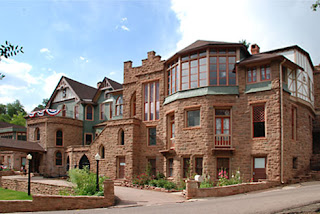
On this page from FRONTDOOR, click HERE , an HGTV website, you can get a pleasant video education on over twenty different ARCHITECTURAL STYLES.
If you are fuzzy as I was, on the difference between MODERN and CONTEMPORARY, or that what is called TUSCAN style in new homes is MEDITERRANEAN, each of these short videos takes you through the history and characteristics of one style, and how it is reflected inside and outside a house.
If your internet connection isn't fast enough and some of the videos start pausing, I found that if a few seconds after a video starts, if you click on the pause, and give it a minute or two, it may play all the way through without pausing again.
After you've finished the series, you should be able to identify the nine architectural styles used in the Miramont Castle (Photo at top) of Manitou Springs, CO, as: Romanesque, Gothic, Moorish, English Tudor, shingle-style Queen Anne, Flemish stepped gables, domestic Elizabethan, Venetian Ogee and half-timber Chateau.
Not all these styles are covered in the videos but Miramont is special to me because I once lived on the other side of the hill from it, and also forever regretted not not buying a house on the steep hill just above the castle which had beautiful views, about like this I clipped from Google maps street view:
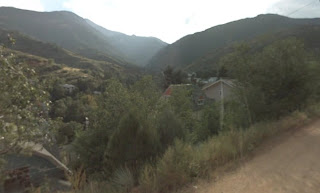
Here's another photo of one of the Victorian B&B's just below the castle.
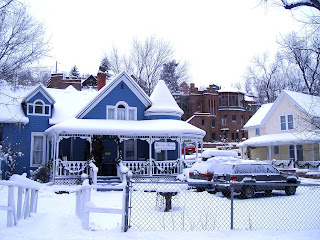
Trailernutz is my blog where I'm going to be posting about anything that pops into my head, not necessary about trailers.
Monday, February 1, 2010
Perfection in a small home by Skyline
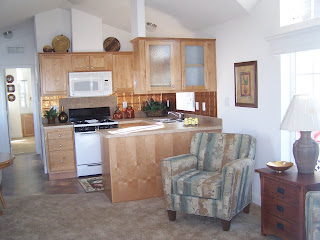
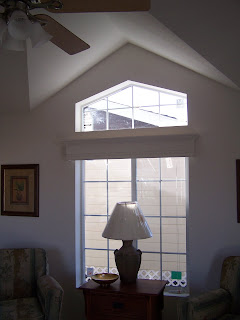
Click on any photo to enlarge.
These are photos of a smaller trailer I love, only 475 sq. ft. It's hard to find the specs on these but as far as I can tell it is what is called a HUD-code park model, that is, a park model larger than 400 sq. ft., that conforms to HUD standards instead of ANSI standards, which are lower. It has better insulation in the roof and floor than most park models, but 2 x 4" walls and R-11 insulation which is unacceptable.
Although this home is just a one bedroom, one bath model, it is the interior space and layout that is striking. These little homes can get very elaborate with dormers and cathedral ceilings, but this one maintains the simplicity but has that one peak in the living room that looks so good. Although I like the copper back-splash in the kitchen, the beauty of this home isn't in the details; it is in the interior form. It comes as close to perfection as I've ever seen in a home of this size.
It is made by Skyline of California.
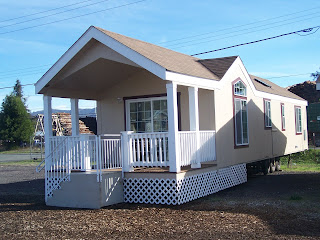
The outside appearance is okay, although I don't like that it doesn't have eaves on the sides. The porch is cute though. It would look better on a foundation, and if had a metal roof and eaves more like this one with wood siding. (Also by Skyline.)
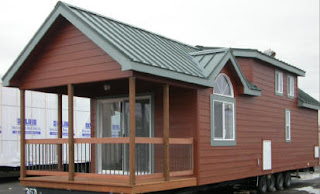
The kitchen might look better with stainless steel or black appliances, better counter tops, without the wood on the base cabinet having a repeating pattern, and the furniture like the dining table, the carpet, the tile could all be improved...but who cares when there are such beautiful shapes in the ceilings and walls. The layout is great and I like the built-ins in the bedroom, the corner sink in the bathroom.
If I lived in a home like this, I don’t think I’d ever get over appreciating all the nice wall shapes and the beautiful ceiling shape over one window (2nd photo) in the living room. It is much more interesting than a flat ceiling or rooms with square walls.
Being so small, it would also be very energy efficient if they could use better insulation and get it up to R20 or so. It has an area for a stack washer/dryer.
The problem is the price, in that this home would probably start edging toward the $52,500 for the 1178 sq. ft. Karsten SF-50 which is very well made, to modular standards, but with less visual excitement inside, but at over twice the size with three bedrooms and two baths. It would be hard to resist going for the larger home.
However, this one bedroom Skyline would be perfect for someone on a property where a larger model wouldn’t fit, cantilevered off a hillside, or for someone who wanted the lower expenses of a smaller home.
I got these photos a few months ago, from a dealer’s site. Some of the more web savvy dealers take photos of the homes on their lots that are for sale. A few even take videos.
All the interior photos are of the same home, the one without the wood siding.
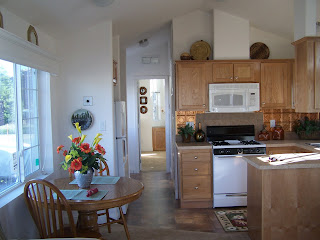
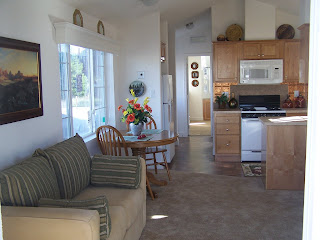
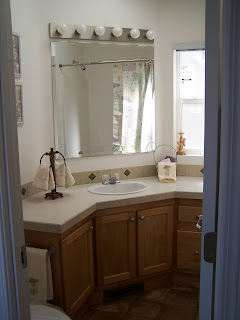
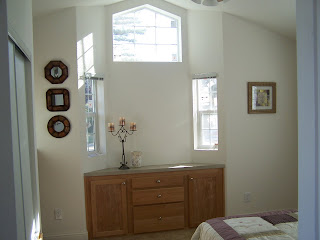
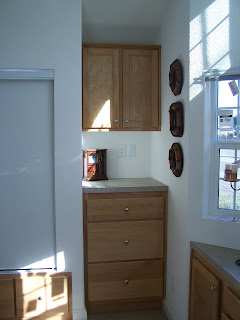
Friday, July 17, 2009
Let's talk single-wide vs. double-wide
Is a double-wide home always a better choice? Definitely not.
I was looking at the new Cavco offerings on line. (Click on “check it out” below under where it says NEW WEBSITE LAUNCH.) Unfortunately, they have mostly floor plans and just a few drawings.
They have a double-wide that is 600 sq. ft. Some of the smaller double-wide manufactured homes can be very cute, but from the drawing, I suspect this one isn’t. But it comes with good options, like upgrade to 2” x 6” walls and R-19 insulation, and R-40 in the roof.
Wall thickness
2” x 6” inch walls means the studs are 2" x 6" boards, thicker than the standard 2” x 4” walls. It makes the structure sturdier and allows for more insulation. It is well worth the upgrade, and many manufacturers of single and double-wide manufactured homes offer it as an upgrade.
Get it! It also makes the home feel more substantial inside, because the window sills are two inches thicker.
Here’s a photo a single-wide home in Albuquerque, a manager's special, for $45,000.

Several things I don’t like:
1. Low ceiling. Hardly more than 7.5 ft. at the peak.
2. 2” x 4” exterior walls and R11 insulation. Probably R20 in the roof.
3. Wood colored molding between the ceiling and wall. This molding should be white, ESPECIALLY in homes with lower ceilings. A dark color draws the eye to the molding, and ceiling look lower. It is a distaction having a dark line running around the room. Many manufactured homes companies do this, including Clayton in a few homes.
4. Hideous wall paper pattern that competes with the floor pattern, AND the wood grain in the cabinets. They are all similar color, but with patterns that compete visually. They clash.
5. Cheap lighting fixtures.
But forget those last things...they come with the territory. It is number 1 and 2 that are important.
-------------------------------------------
Why buy a single-wide like that, when for $52,550 less than $8000 more, you can have something like this, the Karsten SF-50:

1. 9’ flat ceilings throughout. That alone makes a huge difference in the interior. It feels like a stately small home instead of a single-wide.
2. R50 insulation in the ceiling. R19 in 2” x 6” walls. Nice drywall throughout. It will all make for a very energy efficient home.
3. The home is 1185 sq. ft. with two bathrooms and three bedrooms.
4. Nice door trim and moldings, acceptable fixtures instead of cheap looking ones. A very solid home, with a good looking upgrade carpet as well.
So, if you need to have a single wide because that is the lot you have in a park, or all that will fit on your property, or you just want a home about this size, I don’t think there is much better on the market than this SF50 by Karsten. (See link for floor plan.) Gee I sound like a salesman.
It also has a laundry room/area, walk in closet in the master. Closets in the other two bedrooms. The sizes of all the rooms are good. On the Karsten lot in Albuquerque where I saw it, the decorating probably helps too.
On the down side, it is plain on the outside, but well constructed. The window placement is perfect on the inside, but from the outside, it looks unbalanced. The simplicity of it I like though. No kooky looking gables.
Besides the plain exterior, the other weak point is there is no window in the second bathroom. This isn't important. Natural light could be brought into the room with a skylight or sun tube. (Sun tubes don’t heat up as much in the summer, but cost more.)
I have five skylights in my little house. I put foil up against them for two months of the summer. The two larger ones are clear. It makes about a four or five degree difference. In the winter, I like the light, and seeing the stars in the two larger clear skylights at night. Skylights can leak, and get condensation. They have their downside.
Back to extolling the virtues of the Karsten SF50. Because of its energy efficiency, solid construction, and nice interior plan, this home will hold its value better than a 2” x 4” doublewide, even one costing ten or twenty thousand more. A well built home like this Karsten can last as long or longer than a stick built home.
I understand why some people buy the inexpensive, cheaply built homes. It is all they can afford! If your budget is $25,000, to $30,000 there are some very inexpensive single wide homes, which in some cases, might be a better buy than a used one with bad problems.
If you are handy, it is possible to find bargains in used single or double-wide homes, for something like $5000, but you have to know what to look for in the way of problems, and know what you are able to handle, and how much it will cost to fix up, in labor (both your own and others) and money.
On a 30 year old single-wide trailer in my neighborhood, that had an addition, they added solid core foam insulation on the outside, and then put stucco on, and a new roof and front porch. Looks pretty good, and energy efficient too.
I was looking at the new Cavco offerings on line. (Click on “check it out” below under where it says NEW WEBSITE LAUNCH.) Unfortunately, they have mostly floor plans and just a few drawings.
They have a double-wide that is 600 sq. ft. Some of the smaller double-wide manufactured homes can be very cute, but from the drawing, I suspect this one isn’t. But it comes with good options, like upgrade to 2” x 6” walls and R-19 insulation, and R-40 in the roof.
Wall thickness
2” x 6” inch walls means the studs are 2" x 6" boards, thicker than the standard 2” x 4” walls. It makes the structure sturdier and allows for more insulation. It is well worth the upgrade, and many manufacturers of single and double-wide manufactured homes offer it as an upgrade.
Get it! It also makes the home feel more substantial inside, because the window sills are two inches thicker.
Here’s a photo a single-wide home in Albuquerque, a manager's special, for $45,000.

Several things I don’t like:
1. Low ceiling. Hardly more than 7.5 ft. at the peak.
2. 2” x 4” exterior walls and R11 insulation. Probably R20 in the roof.
3. Wood colored molding between the ceiling and wall. This molding should be white, ESPECIALLY in homes with lower ceilings. A dark color draws the eye to the molding, and ceiling look lower. It is a distaction having a dark line running around the room. Many manufactured homes companies do this, including Clayton in a few homes.
4. Hideous wall paper pattern that competes with the floor pattern, AND the wood grain in the cabinets. They are all similar color, but with patterns that compete visually. They clash.
5. Cheap lighting fixtures.
But forget those last things...they come with the territory. It is number 1 and 2 that are important.
-------------------------------------------
Why buy a single-wide like that, when for $52,550 less than $8000 more, you can have something like this, the Karsten SF-50:

1. 9’ flat ceilings throughout. That alone makes a huge difference in the interior. It feels like a stately small home instead of a single-wide.
2. R50 insulation in the ceiling. R19 in 2” x 6” walls. Nice drywall throughout. It will all make for a very energy efficient home.
3. The home is 1185 sq. ft. with two bathrooms and three bedrooms.
4. Nice door trim and moldings, acceptable fixtures instead of cheap looking ones. A very solid home, with a good looking upgrade carpet as well.
So, if you need to have a single wide because that is the lot you have in a park, or all that will fit on your property, or you just want a home about this size, I don’t think there is much better on the market than this SF50 by Karsten. (See link for floor plan.) Gee I sound like a salesman.
It also has a laundry room/area, walk in closet in the master. Closets in the other two bedrooms. The sizes of all the rooms are good. On the Karsten lot in Albuquerque where I saw it, the decorating probably helps too.
On the down side, it is plain on the outside, but well constructed. The window placement is perfect on the inside, but from the outside, it looks unbalanced. The simplicity of it I like though. No kooky looking gables.
Besides the plain exterior, the other weak point is there is no window in the second bathroom. This isn't important. Natural light could be brought into the room with a skylight or sun tube. (Sun tubes don’t heat up as much in the summer, but cost more.)
I have five skylights in my little house. I put foil up against them for two months of the summer. The two larger ones are clear. It makes about a four or five degree difference. In the winter, I like the light, and seeing the stars in the two larger clear skylights at night. Skylights can leak, and get condensation. They have their downside.
Back to extolling the virtues of the Karsten SF50. Because of its energy efficiency, solid construction, and nice interior plan, this home will hold its value better than a 2” x 4” doublewide, even one costing ten or twenty thousand more. A well built home like this Karsten can last as long or longer than a stick built home.
I understand why some people buy the inexpensive, cheaply built homes. It is all they can afford! If your budget is $25,000, to $30,000 there are some very inexpensive single wide homes, which in some cases, might be a better buy than a used one with bad problems.
If you are handy, it is possible to find bargains in used single or double-wide homes, for something like $5000, but you have to know what to look for in the way of problems, and know what you are able to handle, and how much it will cost to fix up, in labor (both your own and others) and money.
On a 30 year old single-wide trailer in my neighborhood, that had an addition, they added solid core foam insulation on the outside, and then put stucco on, and a new roof and front porch. Looks pretty good, and energy efficient too.
Wednesday, November 12, 2008
Trailernutz, the early years

I’m not an architect, home builder, dealer, or an expert of any kind about trailers, but I read a lot, am intuitive and introspective, and don’t take myself too seriously and you shouldn’t either. I enjoy writing and this will be my blog about pretty much anything. But here’s how my thing for trailers began…
In 1959, I was six years old and in love with Marcia, the cute blond next door. I liked her even more when her family got an Airstream trailer. They parked it in their side yard. Marcia and I played house in her trailer and fully expected that we would be married some day, raising children, and living in just such a humble place, be it ever so manufactured.
The trailer was the just right size for us. We were small, happy and innocent. We had no knowledge or appreciation for walls over two inches thick, hardwood floors, Viking appliances, granite counter tops or soaring cathedral ceilings.
Don’t get me wrong, we didn’t spend all that much time in the trailer. Most of the time, we were running around in our big back yards, riding her whirlygig -- a two seat device with a handle each person could pull to make it spin faster until nausea set it -- kicking balls, hiking in the nearby forest and a lot of bike riding. We played marbles, caught lightning bugs in jars, played with matches, climbed trees, built forts, ran with scissors and had impromptu hula hoop contests. I think my record was somewhere around 300 hulas. I don’t want to give the impression my whole childhood was about trailers, as if preparing for a future on the Jerry Springer show. Although, come to think of it, I cheated on Marcia once, with Kathy Demario, who a year or two earlier had taught me to tie my shoes.
I pictured Marcia and I grown up one day, with our brood, taking trips in our trailer to places like Disneyland, Africa, and Mt. Everest. Not the top of Everest course. I was young, not stupid. We had enough trouble getting our car up the hill in the winter. Towing a trailer up a mountain would be impossible.
Only a year after Marcia’s family got the trailer and Marcia and I were firming up plans for a life together, my family moved out of the neighborhood. Our new house was over five miles away. Marcia and I weren’t even in the same elementary school anymore. I knew it was more to do with our basement flooding every time it rained, like the time we got about a foot of water one rainy spring and the sump pump couldn’t keep up with it. That was the last straw for my father. Still, I felt like there was a little Romeo and Juliette going on in this situation. Marcia and I were being separated. It didn’t seem right.
In our new ranch-style house, my next girlfriend -- I worked pretty fast -- was Debbie, also a next-door neighbor. Debbie’s mother was, said in a whisper, “divorced,” currently between husband two and three, so a serial divorcee. Debbie’s grandfather ran a construction business and had built our house and Debbie’s house, and several others in our neighborhood. We lived in a subdivision of homes outside of Vestal, NY, near Binghamton. Binghamton is surrounded by miles of rolling hills, small towns and dairy farms. Vestal is even more rural. Most of the people in the Vestal area in particular, worked in one of the area’s largest two employers. IBM Endicott, or IBM Owego.
In our subdivision, over the next several years after we moved in, many new houses were built up the hill from us. On Sundays, or weekdays when workers went home, I liked exploring the houses in their various stages of construction, and doing things like climbing the ladder to a second floor before the stairs went in. I’d explore them right up until they put the front door hardware on and locked the doors.
I also watched the foundation hole being dug, a crew arriving to set forms for the basement walls, and finally a cement truck pulling in to pour the cement into the forms, using a trough that swiveled and was guided by a worker. Then, the framing, electrical, plumbing, insulation, drywall etc. After seeing it dozens of times, I knew what to expect, but it was always of interest to see the houses go up, and the people move in.
The subdivision was isolated and there was no crime when we first moved in. People even left their doors unlocked. Even though there were piles of lumber lying around on construction sites, and I liked sawing wood and nailing things together, I never took anything from a site. We thought stealing wasn’t right, and besides, getting caught for it would be worse. It would be pretty hard to avoid going down the street with a 2 x 4, without someone noticing.
Debbie’s grandfather built a dozen of the new houses but there were many other builders too, and after a short while, he retired with his wife, to a farm. In my neighborhood, most of the houses were small ranch houses with a one-car garage but then they started building a lot more split-level homes with two bathrooms, and a bigger garages. When they reached ten blocks to the top of the hill, some houses were custom two stories, that probably had two and a half or even three baths.
Our house, a modest brick ranch, had only one bathroom. It was fairly well made, except for the cheap plastic tile in the bathroom that started falling off in the shower a year after we moved in.
Debbie and I didn’t have any trailer connection to speak of until she moved away. Debbie, her mother and her new step-father moved to her maternal grandparent’s farm. There, they lived in a new trailer on the property about a hundred yards from the parents large Victorian farm house. I thought if a builder of homes, even a retired one, would house his only daughter in a trailer, they must be great. After they were there for a month, I was invited to come stay for a week on the farm. Debbie missed me.
Kids pick up on adult things. I didn’t know squat about sex at the time. In retrospect, the reason they all moved to this isolated farm, was that Debbie’s mother’s first two husbands cheated so much, this was a way of isolating her relationship with this third stud. The grandparents could keep an eye on him, while working him to death with farm chores. He’d be too exhausted to cheat. He had a couple of farmhands to help him out with some things, but it was mostly him.
They had about twenty milk cows, a dozen beef cattle (with plans for more), chickens, a goat and a couple of horses, including a pony that Debbie and I would get to ride, while led on a rope by her step-father. Whoopee!
When I pictured a week at the ranch, and horse riding, I thought it was going to be like Roy Rogers or Sky King, and we’d be taking off on adventures into the hills, galloping away through fields of wildflowers. Debbie’s grandparents even bought me a fancy cowboy hat. What did I need that for. I wasn’t into cowboy drag for some stinkin’ fashion statement/pony ride/photo opportunity. I wanted to ride a horse off into the fields or at least learn some horsemanship skills, maybe win a race, like Elizabeth Taylor in National Velvet.
Never mind that I was only 9, and Debbie 7, and they didn’t want their precious little Debbie to break her neck. Neither of us had been on a horse much, except the pony ride once or twice at a county fair.
I was familiar with cows. Where we lived, we got our milk at a dairy right next door, and you could go in and pet them. I pet a cow once or twice, not heavily. They were also in the field at the end of one street near us, only five houses away. It was our game to get under the electric fence, without getting a shock, feeling that if the fence touched the head, we’d get amnesia. I never tried that, it was bad enough touching the fence with a finger.
But what fun are cows? They moo. They swipe flies with their tails. They sometimes look at you with big brown eyes that say “Help me, I’m a cow, and ready to reincarnate into something more exciting like a dog,” and they take lots of dumps. Oh, I almost forgot. They make milk. A bottle or carton was fine with me. Why marry the cow, when you could buy bottles in the store, or something like that.
Not only couldn’t we take off on the horses, I didn’t even get to stay in the new single-wide trailer with Debbie and her parents. They stuck me in the grandparent’s farmhouse. For a few days, I didn’t even go in the trailer, although I wanted to, but finally, we ate dinner there once and I got an abbreviated tour. I didn’t like it as much as a camping trailer, and it was pretty cheesy looking, but it was much better than a farmhouse. The rest of the time, everything -- meals, relaxing indoors, sleeping -- was at the grandparents’ house.
I slept in a huge dark bedroom on the second floor of the house, all by myself. The only thing I liked about the home was the staircase that curved down into the living room. When the adults were out of the house for a few minutes, Debbie and I finally got in some good banister sliding. Probably the most exciting thing we did all week.
Debbie’s grandmother was always baking, and at meals, they were trying to fatten me up, which was never successful, especially if they made something like peas. How fat could I get in one week anyway?
I ate like a bird, except fruit, and they didn’t serve fruit. I could eat three or four apples at a time. I could eat peaches or blueberries until my stomach hurt. For them, fruit belonged only in pie. I hated pie. When I told them I didn’t like pie or cake, you would have thought they discovered my membership card to the communist party, or that I’d bit the head off one of their chickens. One relief about breakfast, it was the one meal they weren’t trying to force pie on me.
What I wanted to do, was spend a night in the trailer with Debbie, which they wouldn’t allow. Marcia and I certainly had never got to spend our magic night in her camping trailer, and with Debbie, I began to doubt that I’d ever get to stay in one. It was all about the trailer, not so much Debbie.
Worse than almost being banned from the trailer, was that there was NOTHING to do on the blasted farm. I had no bicycle. They had dozens of acres going up into the hills, but not only could we not ride horses, we couldn’t even walk out there. The few beef cattle “might stampede us.” It would inflame Debbie’s allergies. She might get poison ivy. We might drown in the foot-deep creek.
The farm was bounded by a two-lane highway on one side and fenced hills on the other. It seemed like we were a mile away from the next house. We couldn’t go near either the hills or the highway. At home, I was used to riding my bike all over, even during snowy winters at times, exploring the endless woods above our house, playing at the creek which had a waterfall. The creek led down to the wide Susquehanna river, and in dryer weather, was easy to get to by walking through under passes, not even having to cross a highway. I also had lots of neighborhood friends and we spent summers playing games, exploring or riding our bikes.
At the farm, there was nothing to do but watch the cows get hooked up to the milking machine. Once was enough of that. Watch Debbie’s step-father pitch hay in the barn or feed the horses. Debbie had to take a long afternoon nap, and at first they tried to make me take one too, but after one time, when I told them I slept like hell at night if I fell asleep during the day, I was free. So, they let me wander around when Debbie was napping for two hours. That girl slept more than a newborn.
When Debbie was napping, I’d go into the barn to look at the animals. I tried to talk to Debbie’s step father a few times, but he was busy working, not much of a talker, and when he did talk, the things he said made me appreciate the intelligence and speaking ability of my parents. I don’t think he was a moron. He just didn’t know what to say to a nine year old person.
According to the first joke I learned in Kindergarten, you could make time fly by throwing a clock out the window. By the end of the week, I was ready to throw Debbie holding a clock out the window, to see if time and Debbie could fly, or do just about anything but cry or whine all the time. She could be a cranky little girl.
Debbie’s mother was usually nice to me, but she was forever bitchy and demanding to Debbie, especially if she ran out of cigarettes. The way she chained smoked -- I expected her to light a second cigarette at any moment and smoke two at a time -- you would think they’d keep a few crates of cigarettes in the barn or something. In that way, she wouldn’t run out. I could see Debbie was headed in the same direction, at least regarding being frustrated and demanding. Not even newlywed bliss helped her mother much.
The week finally ended, and my parents picked me up and I was happy to get back to civilization, freedom and TV. They had a TV on the farm but it got only one fuzzy channel. The adults sat around playing cards, smoking and talking about nothing. Not a reader of books in the bunch, although I suppose they talked about current affairs, which didn’t interest me at that age.
Boredom can be a harrowing experience for a kid. My parents both came from large families and I never had trouble making conversation with most of my relatives, but I couldn’t talk about anything with Debbie’s parents or grandparents. After a full week of Debbie, I didn’t have much to say to her either. Later, when I’d hear that expression “funny farm,” I’d think of that farm, and how nuts I’d go if I had to live there forever. I felt sorry for Debbie, that she was stuck there, with no friends to play with, not places to go, and with her bitchy mother.
For some reason, around these people, I was in a shell and never comfortable, afraid that I would do or say the wrong thing. They were absurdly overprotective of Debbie and perhaps for that reason, when I met up with her in high school years later, I wasn’t that surprised to discover she rebelled.
Her locker was near the library, and on my way down to read books in the library after I finished lunch, she would sometimes be there, back glued to her locker, face shrouded in heavy makeup, making out with one of the class hoods. Her boyfriend looked to be about 19, held back a few times, and except for auto shop and gym, he was one of the students who was in the “math skills” class where they learned their plusses and guzintas instead of algebra and geometry. Two plus two is four. Four guzinta eight twice. Besides making out, which was in strict violation of the school’s PDA (Public Display of Affection) rule, Debbie no doubt shared this thug’s penchant for smoking cigarettes behind the gym, and of course Debbie got knocked up (or as Sarah Palin would say “blessed” with child) by the time she was a sophomore. Maybe she didn’t have four husbands by the time she was thirty, but she seemed to be well ahead of her mother’s baby-making schedule.
Getting back to childhood, when I got home that summer, and Debbie remained a prisoner thirty miles away on the farm, I set my sights on Patty, who lived two houses down the street. I met her playing with the neighborhood kids. She played the clarinet. She was wonderful.
Patty was a whole year older than me, smart, fun, athletic, long brown hair, and we had lots of good times together for a few years. We climbed trees and played with her father’s tape recorder, sang and made music together. She didn’t have a camping trailer though. It didn’t seem to matter. I knew one day we would.
Her parents and three sisters liked me. There was no attempted force feeding of pie at meals, and they didn’t regard me as a communist for not eating it. In fact, they ate fresh fruit too. Patty and I drifted apart when she went to junior high, but we met up in high school Biology class. We were friendly. Patty went from outgoing and athletic, to big and shy. She was still someone I liked though. I didn’t understand why she became so shy. She went from being coordinated and sporty, to someone who looked uncomfortable in her growing body. She was tall too. Back in the third grade when I started seeing Patty, we faded until when she left for junior high a year ahead of me. I know, you’re wondering, where is the trailer in this story?
When I was home from my first year in college for a holiday, my mother told me she had lunch with Patty’s mother. They weren’t close friends, but were still friendly. Patty’s mother had started reminiscing about when Patty and I were children. She reminded my mother that when I was in the third grade, and Patty in fourth, Patty and I made a vow that we would marry each other and more importantly, that we would live in a trailer. When my mother told me that, I laughed and said it was all true.
The best made trailer plans of mice and men often go awry.
Subscribe to:
Comments (Atom)
